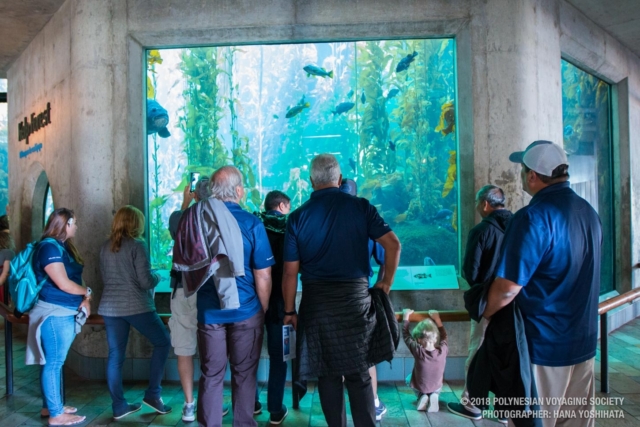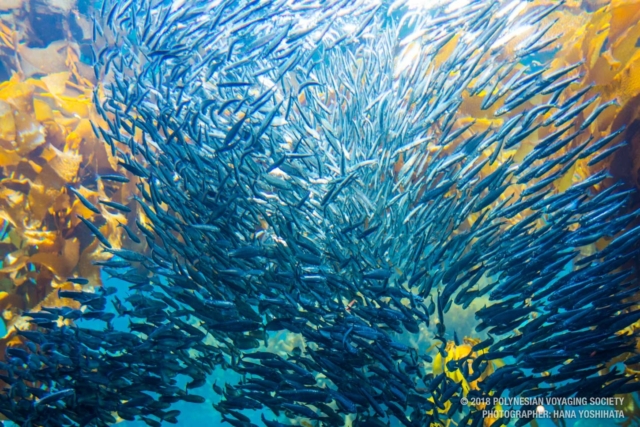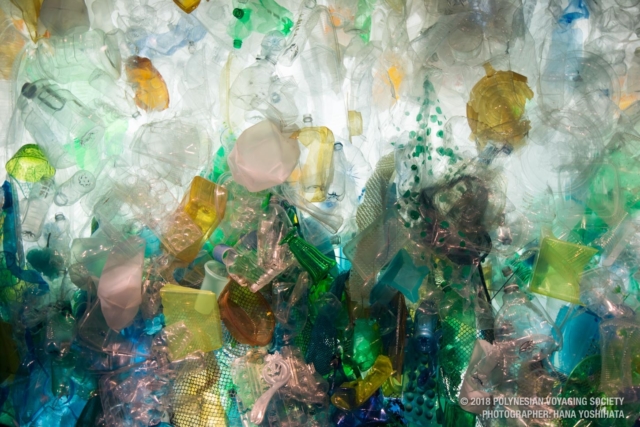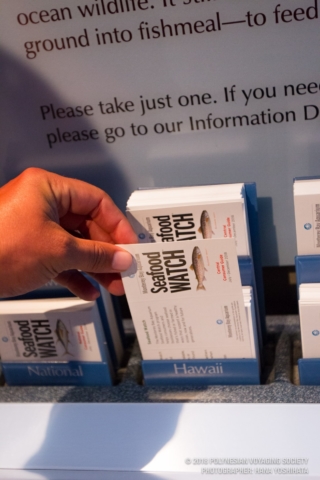
Hikianalia Crew Blog | Matt Caires: One Pacific ‘Ohana
- Posted on 12 Oct 2018
- In Crew Blogs, Featured, Malama Honua Selects, Newsletter, Photo Galleries, Science, Stories of Place, Teachers, Uncategorized
 Crew blog by Matt Caires
Crew blog by Matt Caires
Reflections from Monterey Bay, Part One
What was once a heavy supplier of sardines to the world, Monterey Bay was best known to those outside California, by the descriptions from writer John Steinbeck, who carefully described Monterey, and its economic hub – Cannery Row, in his famous novel of the same name, writing:
“Cannery Row in Monterey in California is a poem, a stink, a grating noise, a quality of light, a tone, a habit, a nostalgia, a dream. Cannery Row is the gathered and scattered, tin and iron and rust and splintered wood, chipped pavement and weedy lots and junk heaps, sardine canneries of corrugated iron …”
Supported by a bay with a seemingly limitless number of marine resources, there was economic prosperity, at the expense of natural resources both in the ocean and on the land. When the last cannery closed in the 1970s after the collapse of the fishery, the industrial impact on the shoreline remained. A generation later, from the ashes of the shuttered canneries rose a new ethos, and a new way of looking at our ocean resources, which is anchored by the Monterey Bay Aquarium.
The Aquarium’s mission, to inspire conservation of the ocean, is alive and reflected in its staff, how the animals are cared for, and educational materials that accompany the exhibits. Crewmembers, many of whom had never been to California, were surprised to see the abundance and diversity of life in the California exhibits such as the Kelp Forest Exhibit. But with this surprise, also came a sense of connection, that while different, many of the animals shared traits with their tropical cousins – whether it be crustaceans like the wana (sea urchin), bat rays, leopard sharks, terns, or the giant sea bass, we were reminded that we are all part of one Pacific Ocean family.
The highlight of the huakaʻi for some crewmembers were the African Penguins. The Aquarium is one of a few controlled habitats that are helping to breed and maintain the genetic diversity of these endangered species. Aquarium Bird Manager Aimee arranged for a meeting with Rey, one of the more social penguins. The interaction was especially meaningful to the crew after crewmember Billy Richards shared that Hōkūleʻa and her crew sailed past colonies of African Penguins along the South African coast on the Mālama Honua Worldwide Voyage. The connection to Hōkūleʻa and now Hikianalia to these beautiful and intelligent animals deepened the crew’s belief in the interconnectedness of life in our oceans and appreciation to the Aquarium for their conservation efforts.
While our waʻa were connected to these special animals, the crew had an opportunity to see the namesake of this voyage – Alahua Kai o Maleka – in action. Alahua Kai O Maleka, or the well-worn ocean path to America, has different meanings to each crewmember, but when the crew had the opportunity to meet a special Laysan Albatross, we were united in understanding just how connected we as pacific ocean people, need to be, in order to sustain the health and wellness of our common backyard – the Pacific Ocean.
Aquarium Bird Expert Nikki introduced the crew to Alika, a Laysan Albatross that the Aquarium had nursed back to health and was now helping it with rehabilitation after a wing injury. Alika we learned was actually injured in 2015 at Kaʻena Point when he and many other Albatross were killed and injured by Hawaiʻi teenagers. As tragic and senseless as that was, seeing Alika, a survivor of that massacre in Hawaiʻi, being cared for by conservationists in California, cemented the bond between our two places. And, just as the Albatross travels across the well-worn path of Pacific, we too, by voyaging to California, are continuing to maintain that connection.
While conservation and healthy ecosystem management is a theme in many exhibits, the Aquarium’s public education and outreach extended to one of the more pressing issues facing the Pacific and all oceans – the expansive proliferation of plastic pollution. The issue goes beyond the visible plastic we can see with our naked eye, and starts at the bottom of the food chain. Plankton, which are on display in The Deep exhibit, are the size of many of the microplastics that have entered the ecosystem. Mistaking microplastics for plankton, jellyfish and smaller fish on the food chain will ingest these microplastics which then accumulate in tissue, and eventually, will end up in pelagic species that we eat.
The crew spent considerable time in this portion of the exhibit to learn about the myriad of ways that plastic can enter not just the animals but our food chain. Although a stark thought, the crew was impressed to see that the Aquarium practiced what it preached, as, in fact, there is no single use plastic in the entire Aquarium. Gift shops did not offer plastic bags, or have plastic hangers, and the cafeteria only offered products in metal or glass containers, paper straws, and reusable utensils and plates.
Continuing their commitment to conservation, the Aquarium started a subsidiary nonprofit – Seafood Watch. For those in Hawaiʻi, many may have seen the Seafood Watch logo in Whole Foods and other businesses. Initially a pilot project for California, the organization’s focus is to education businesses and consumers to use their purchasing power to drive change in fishing to encourage more sustainable fishing practices. The organization now produces education cards for several fishery regions of North America, including Hawaiʻi, detailing the types of species and fishing methods that are good, better, and those that should be avoided when purchasing fish. Following the guidelines, the crew, in provisioning the canoe for its 4-day trip to Ventura, chose species of rock cod and shrimp that were the most sustainable option for central California.
Although the many naturalists working at the Aquarium were thankful for what they learned from Hikianalia and her crew, the consensus among the crew was that we learned much more from their work and their application of the mission to inspire conservation of the ocean. From its commitment to conserving and rehabilitating all ocean life in the Pacific, to reducing and in some cases, eliminating single use plastics, there were many best practices the crew can take back to Hawaiʻi to inspire and continue that same conservation effort over Alahua Kai O Maleka in our shared backyard – the Pacific Ocean.


























